
ISSN: 2321 9653; IC Value: 45.98; SJ Impact Factor: 7.538

Volume 10 Issue XI Nov 2022 Available at www.ijraset.com


ISSN: 2321 9653; IC Value: 45.98; SJ Impact Factor: 7.538

Volume 10 Issue XI Nov 2022 Available at www.ijraset.com
Nayan Magare1, M.S. Harne2 ,
1, 2 Department of Mechanical Engineering, Government College of Engineering, Aurangabad
Abstract: The method of producing three dimensional solid items from digital data is known as additive manufacturing (AM), sometimes known as 3-D printing. A rapidly expanding additive manufacturing technique with several applications is fused deposition modeling (FDM). In this study, we investigate how the orientation, infill pattern, and density of the infill affect the impact strength of the ASTM D 256 specimens. A 3 printer with Acrylonitrile Butadiene Styrene (ABS) filament material has been used in this study. To evaluate the impact strength of the printed object and represent their quality, an ASTM D256 specimen standard has been used. The various parameters for the experiment were selected using OVAT analysis. With the help of a design of experiments (DOE) using Taguchi's L9 Array along with infill pattern, orientation, and density, the operational dependence is examined. When analysis of variance (ANOVA) is used to identify the relevant 3D printing process parameter it is shows that orientation and infill pattern are most significant parameters for impact strength.
Keywords: 3D printing, process parameters, Impact strength, Fused deposition modeling(FDM), Acrylonitrile Butadiene Styrene (ABS).
There has been an increase in additive manufacturing (AM) techniques over the past few decades, which has benefited engineering design and production operations. Recent advancements in 3D printing technology have significantly decreased the time and cost involved with the technique modern electrical technologies are developing. Many researchers have started to investigate the method as a result of the reducing operating costs of 3D printing. The technology provides benefits over traditional manufacturing methods, including the ability to manufacture multi material objects with great dimensional accuracy and highly complicated geometries without the need of tools. The method of fused deposition modeling (FDM), which uses thermoplastic filaments that are melted, extruded, and deposited, is one of the various types of additive manufacturing(AM) techniques. [1 2] The most significant benefit of 3 D printing, out of all its many positive aspects, is that it allows for the layer by layer construction of practically any complicated design. As a result, there is minimal to no waste created throughout the process, making this technique extremely advantageous from the perspective of waste management. The influence of FDM 3 D Printing Process parameter on the mechanical characteristics of an (FDM) printed item is the subject of several research. As a response, it's essential to evaluate how an object's mechanical qualities respond to changes in the process parameters. [3]
B. Aloyaydi et al. in 2020 studied the effect of infill patterns on mechanical behaviour of 3 D printed poly lactic acid (PLA). In the current study the influence of several infill patterns grid, triangle, tri hexagon and quarter cubic pattern on mechanical characteristic of the (PLA) material discussed The results showed that the mechanical characteristic of both impact and compression Strength were highly influenced by the type of infill pattern used during printing.[5] P. Kumar Mishra et al. in 2020 studied the overall effect of various infill patterns and densities on the impact resistance of 3D printed polylactic acid(PLA) object. The influence of the several process variables, such as infill density and infill pattern of PLA by 3D printing on impact strength, is described in the current study. The result shows a tendency towards infill pattern had an effect on Impact strength of PLA sample.[6] H. Dave et al. in 2021 studied the impact of the infill patterns and densities at different component orientations here on mechanical characteristics of the (PLA) object manufactured by FDM printing. A full factorial experiment was carried out to investigate the influence of FDM process variables, and statistical analysis was performed used a ANOVA. [7]

ISSN: 2321 9653; IC Value: 45.98; SJ Impact Factor: 7.538 Volume 10 Issue XI Nov 2022 Available at www.ijraset.com

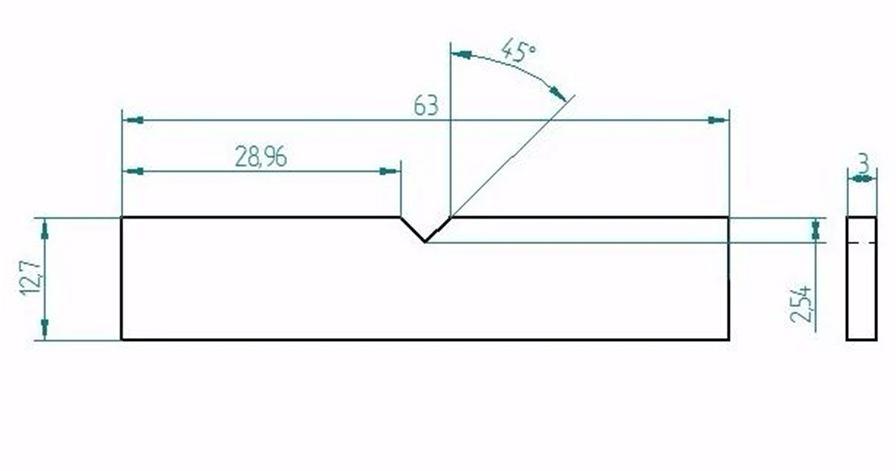
In this study, the printing of test specimen is done with the Acrylonitrile Butadiene Styrene (ABS) material. As seen in figure 3, these test specimens were manufactured using a single extruder FDM type 3D printer For material like PLA, ABS, etc., the maximum nozzle temperature that can be achieved with this machine is 260 . Table no. 1 gives technical details of 3D printing device utilized for the experiment. The impact test uses a standard specimen that refers to ASTM D256. The exact testing specimen printed for testing is shown in the Figure 1 & 2, together with its standard dimensions. The specimen for the impact strength test was manufactured using a 3D printing machine (Pratham 3D printer) and an ASTM D256 standard. The specimens were created using the FDM technique with ABS filament in the 'Ultimaker Cura 4.4.0' 3D printer using the appropriate process parameters, also we used some fixed parameter like nozzle temperature at235 , layer thickness is 0.1mm and printing bed temperature at 80 .The 'Ultimaker Cura 4.4.0' software was used to choose the infill density and infill pattern. The Specimens were tested on the Analogue Izod Impact Tester machine shown in the figure 4 at the Maharashtra Institute of Technology’s testing lab facilities in Aurangabad (MH), India. It is a recognized industry leader in the polymer and plastics. Table no.2 contains the machines specification for the Analogue Izod Impact Tester.
Table 1. (FDM) 3D Printer Specifications
3D Printer’s Specification:
Manufacturer Pratham 3 D Printer Machine type
FDM Single Extruder Type Maximum Printable Area (Width, Breath and Height) 200 * 200 *250 mm Material Acrylonitrile Butadiene Styrene (ABS) White Diameter of Filament Φ 1.75mm Diameter of Nozzle Φ 0.4mm
Table 2. Analogue Izod Impact Tester’s Specifications
Particulars Specification Capacity Up to 21.68 Joules
Release angle of pendulum 150 degree
Range of four scales 0 2.71 joules, 0 5.42 joules, 0 10.84 joules, 0 21.68 joules
Minimum resolution on scale 0.02 joule, 0.05 joule, 0.1 joule and 0.2 joule respectively
Figure 1. Izod impact test sample in accordance with ASTM D256.

ISSN: 2321 9653; IC Value: 45.98; SJ Impact Factor: 7.538

Volume 10 Issue XI Nov 2022 Available at www.ijraset.com
Figure 2. Specimen of Impact
Figure 3. (FDM) 3D Printer
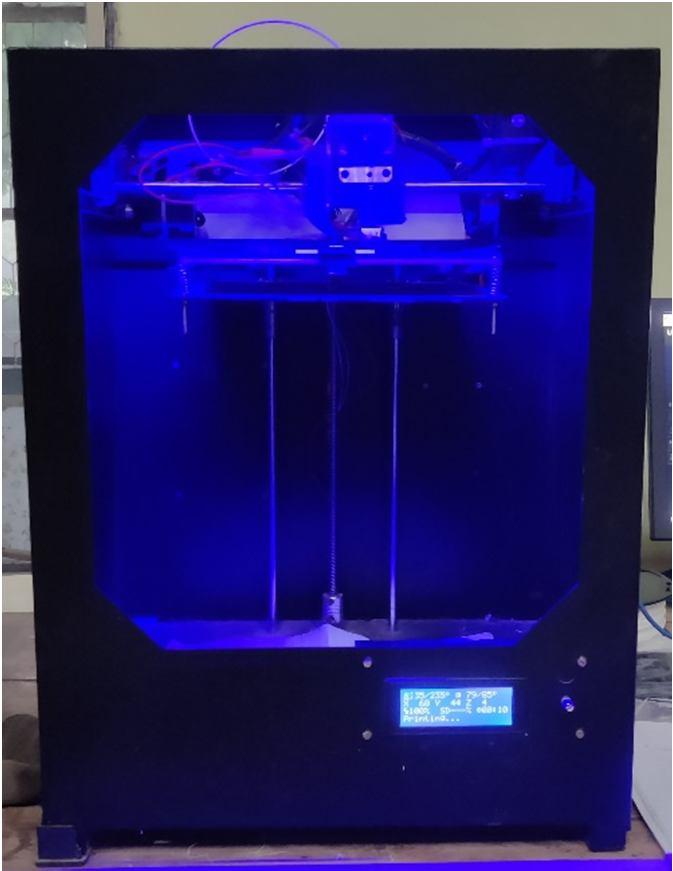
Figure 4. Izod Impact Tester

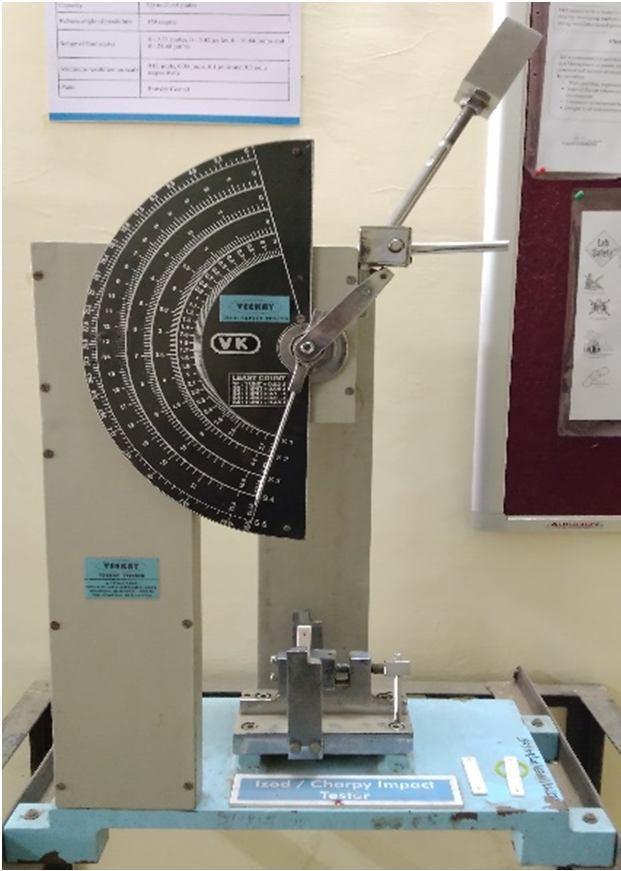
In this investigation, the specimen was subjected to an impact test to examine its mechanical characteristics. The design of the experiment was done using the L9 orthogonal array of the Taguchi method. To identify the crucial parameter range for ANOVA analysis, a One variable at a time (OVAT) study is conducted on each of the three optimization parameter that were selected. The values of (OVAT) analysis’s process parameters are displayed in table 3 below. The behaviour of the graphs is taken into consideration while selecting the proper ranges of the value for optimization.
Table 3 Process Parameters for (OVAT) Analysis
Parameter I II III IV V

Orientation Flat Edge Side On Edge Top Edge Inclined Edge
Infill Patterns Cubic Cubic Subdivision Concentric Tri Hexagon Linear
Infill Density 20 40 60 80 100
1) Analysis of Orientation using (OVAT): Throughout the (OVAT) analysis of orientation, Infill Pattern and Infill Density were kept constant at Cubic and 20 % respectively with 0.3mm layer height thickness This inverted curve was generated by increasing the impact strength for the orientation from flat edge to side on edge and then decreasing with the top edge to inclined edge.
2) Analysis of Infill Pattern using (OVAT): Throughout the (OVAT) analysis of Infill Pattern, Orientation and Infill Density were kept constant at Flat edge and 20 % respectively with 0.3mm layer height thickness With infill patterns such cubic subdivision, concentric, and tri hexagon, it was found that impact strength was significantly increased. Thus, it was observed that the crucial range for an infill pattern included cubic subdivision, concentric, and tri hexagon patterns
3) Analysis of Infill Density using (OVAT): Throughout the (OVAT) analysis of Infill Density, Orientation and Infill Pattern were kept constant at Flat edge and cubic pattern respectively with 0.3mm layer height thickness. The Impact strength goes on increasing with increase in infill density. Impact strength was shown to significantly increase with an increase in infill density. For infill density below 60 % impact strength obtained is very low. 60 % to 100 % was found to be critical range for infill density.
ISSN: 2321 9653; IC Value: 45.98; SJ Impact Factor: 7.538 Volume 10 Issue XI Nov 2022 Available at www.ijraset.com

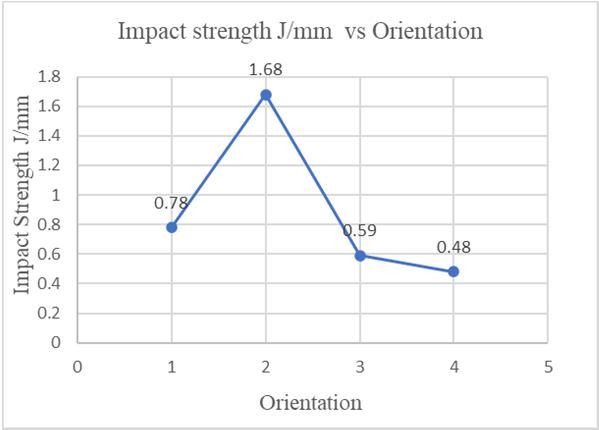

According to the results of the (OVAT) analysis, the following ranges of process parameters were evaluated for (ANOVA) analysis, as shown in table no.4

Prosses Parameter I II III Orientation Flat Edge Side on Edge Top Edge Infill Pattern Cubic Subdivision Concentric Tri Hexagon Infill Density 60 % 80 % 100 %
Using these parameter levels, 9 specimens were constructed for the ANOVA analysis using combinations of the L9 orthogonal array. These specimens were then tested on the previously mentioned Izod Impact tester equipment.
In this study, the impact of three distinct fused deposition modeling (FDM) 3D printing process variables was investigated for the Impact strength criterion Table no. 5 shows the experimental result of Impact Strength. The experimental results were analyzed using the Minitab 2020 software.
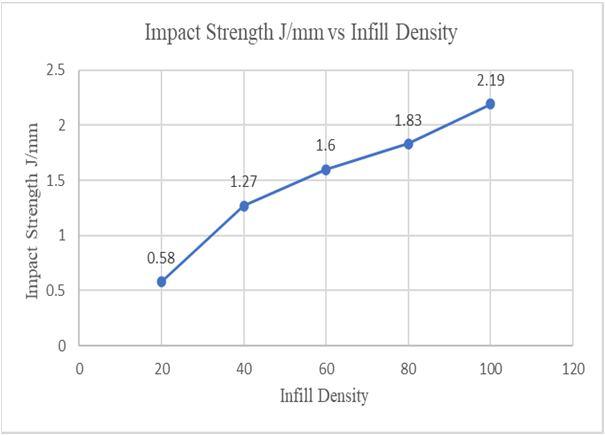
Table 5 Response Table for (Impact strength)
Experiment No. Orientation Infill pattern Infill density Impact Strength (J/mm)
1
Flat Cubic Subdivision 60 1.23 2 Flat Concentric 80 4.27 3 Flat Tri Hexagon 100 2.62 4 Side on Cubic Subdivision 80 2.90 5 Side on Concentric 100 6.87 6 Side on Tri Hexagon 60 2.04 7 Top Cubic Subdivision 100 1.20 8 Top Concentric 60 1.03 9 Top Tri Hexagon 80 1.05
This is an overview of how various process factors affect impact strength.
1) Effect of Orientation: According to the AVOVA analysis, orientation is a highly significant parameter, Orientation has a 45.19% percentage contribution. Level 2 of orientation (side on) reflects the better result of the studied parameters.
2) Effect of Infill Pattern: For each sample the infill pattern had significant influence on the impact strength of ABS. The Concentric infill pattern seemed to encourage higher impact strength in this study. The infill pattern's level 2 (Concentric) ultimately indicates the highest value.
ISSN: 2321 9653; IC Value: 45.98; SJ Impact Factor: 7.538 Volume 10 Issue XI Nov 2022 Available at www.ijraset.com

3) Effect of Infill Density: The infill density has huge influence on the number of layers required to print a part, which in turn has an impact on printing time. The analysis shows that infill density has a 23.97% percentage contribution indicating it is a less significant parameter as compared to infill patterns. Effect of infill density on response factor i.e Figure 6 and 7 shows how impact strength is maximum between 80% and 100%.
Table.6 (ANOVA) calculations for Means (Impact Strength).
Source DF Seq SS Adj SS Adj MS F Value P Value Contribution
Regression 5 2.36719 2.36719 0.47344 22.32 0.014 97.38% Infill Density 1 0.58172 0.58172 0.58172 27.42 0.014 23.93% Orientation 2 1.09838 1.09838 0.54919 25.89 0.013 45.19% Infill Patterns 2 0.6871 0.6871 0.34355 16.19 0.025 28.27% Error 3 0.06365 0.06365 0.02122 2.62%
Total 8 2.43084 100.00%
The P value indicates that the three factors most significantly influencing impact strength are infill density, orientation and infill pattern. The percentage contribution of Orientation, Infill Pattern, and Infill Density are 45.19%, 28.27% and 23.97% respectively. While doing optimization, "Larger is better" criteria are taken into consideration. Figure 6 and 7 represent the signal to noise (S/N) ratio and mean of the means, respectively. The values obtained for highest impact strength under the present investigation circumstances are level 2 of Orientation, level 2 of the Infill pattern, and level 3 of the infill density.
Figure 6. Main Effects Plot for Means
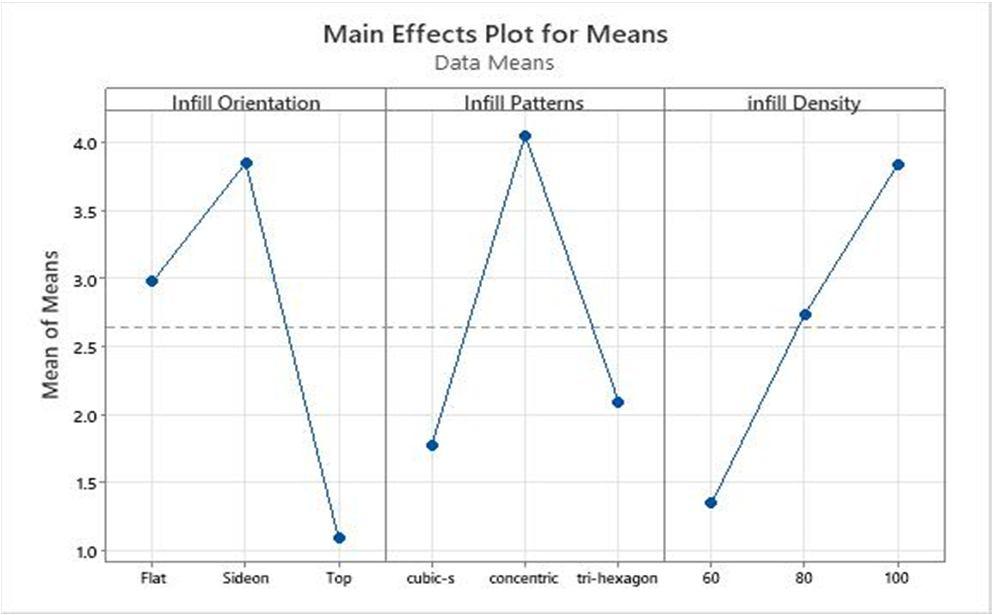
Figure 7. Main Effect Plot for S/N ratio
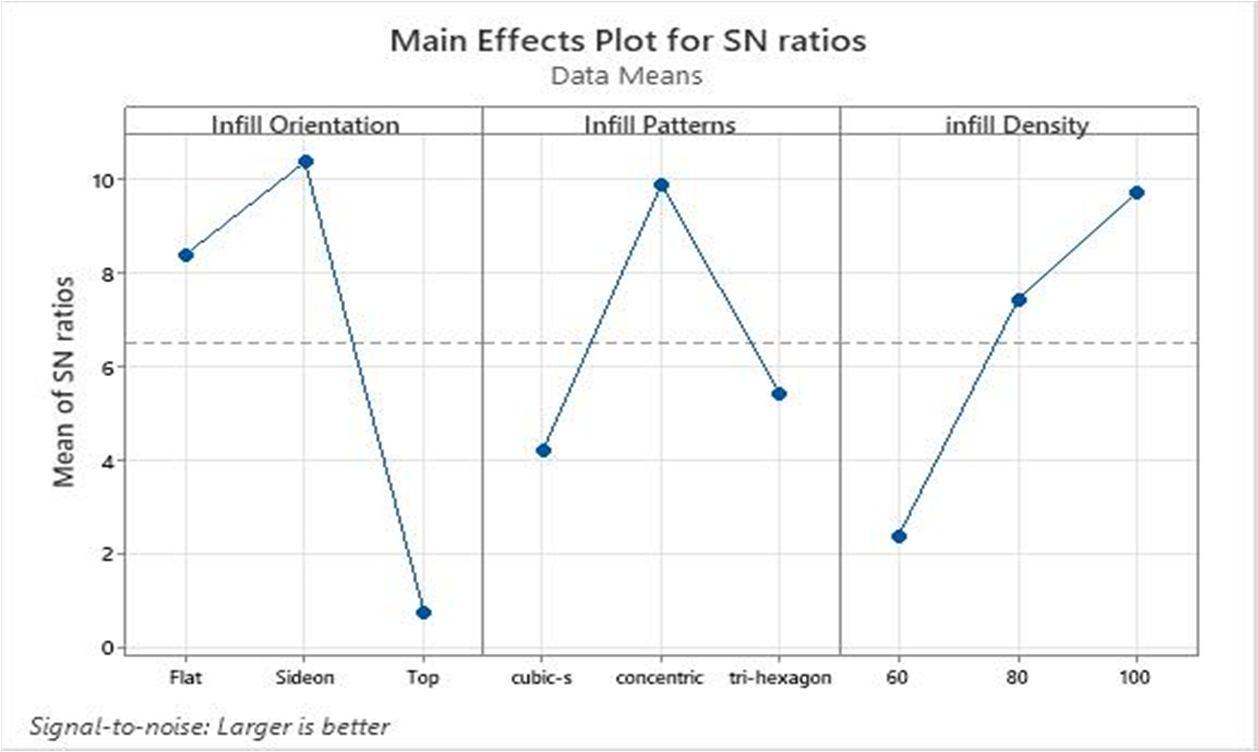

ISSN: 2321 9653; IC Value: 45.98; SJ Impact Factor: 7.538 Volume 10 Issue XI Nov 2022 Available at www.ijraset.com

The impact strength of the 3D printed object was thoroughly investigated to determine the influence of orientations, infill patterns, and infill density. The outcomes of the regression analysis using the Taguchi technique were 93% fitted. The orientation was the primary factor that influenced the impact strength. The results showed equal contributions from the infill patterns and densities. The most significant process parameter according to an ANOVA analysis, is orientation, which is followed by infill patterns and infill densities. The optimum process parameter of (side on) orientation, concentric infill pattern, and 100% of infill density results in the highest impact strength. This procedure is used to enhance the mechanical properties of various components made of various materials.
I am grateful that the Government College of Engineering Aurangabad (GECA), in Aurangabad Maharashtra offered the 3D printing production facilities for the study. I also appreciate the Maharashtra Institute of Technology in Aurangabad, Maharashtra for providing the Impact testing facilities for this work.
[1] Pathan, Aman N., and Sanjay Chikalthankar. "Influence of the FDM 3D Printing Process Parameters on In Layer and the Inter Layer Fracture under Tensile Failure." Int. J. Res. Appl. Sci. Eng. Technol 8, no. 12 (2020): 215 222.
[2] Sapkal, Surekha, M. S. Harne, Umakant Landage, and Aman Pathan. "Parametric Investigations of 3D Printing of Fused Deposition Manufactured (FDM) Structures of Polylactic Acid (PLA)."

[3] Lennert, József Richárd, and József Sárosi. "Investigation of 3D Printing Parameters Affecting the Impact Strength." Annals of the Faculty of Engineering Hunedoara 19, no. 2 (2021): 133 139.
[4] Naik, Mahesh, and Dineshsingh G. Thakur. "Experimental investigation of effect of printing parameters on impact strength of the bio inspired 3D printed specimen." Sādhanā 46, no. 3 (2021): 1 9.
[5] Aloyaydi, Bandar, Subbarayan Sivasankaran, and Ammar Mustafa. "Investigation of infill patterns on mechanical response of 3D printed poly lactic acid." Polymer Testing 87 (2020): 106557.
[6] Mishra, Pradeep Kumar, P. Senthil, S. Adarsh, and M. S. Anoop. "An investigation to study the combined effect of different infill pattern and infill density on the impact strength of 3D printed polylactic acid parts." Composites Communications 24 (2021): 100605.
[7] Dave, Harshit K., Naushil H. Patadiya, Ashish R. Prajapati, and Shilpesh R. Rajpurohit. "Effect of infill pattern and infill density at varying part orientation on tensile properties of fused deposition modeling printed poly lactic acid part." Proceedings of the Institution of Mechanical Engineers, Part C: Journal of Mechanical Engineering Science 235, no. 10 (2021): 1811 1827.
